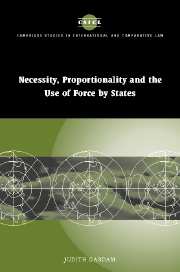Book contents
- Frontmatter
- Contents
- Foreword
- Preface
- Acknowledgments
- Table of cases
- List of abbreviations
- 1 The place of necessity and proportionality in restraints on the forceful actions of States
- 2 Necessity, proportionality and the forceful actions of States prior to the adoption of the United Nations Charter in 1945
- 3 Proportionality and combatants in modern international humanitarian law
- 4 Proportionality and civilians in modern international humanitarian law
- 5 Necessity, proportionality and the unilateral use of force in the era of the United Nations Charter
- 6 Necessity, proportionality and the United Nations system: collective actions involving the use of force
- Bibliography
- Index
- Cambridge Studies in International and Comparative Law
3 - Proportionality and combatants in modern international humanitarian law
Published online by Cambridge University Press: 16 July 2009
- Frontmatter
- Contents
- Foreword
- Preface
- Acknowledgments
- Table of cases
- List of abbreviations
- 1 The place of necessity and proportionality in restraints on the forceful actions of States
- 2 Necessity, proportionality and the forceful actions of States prior to the adoption of the United Nations Charter in 1945
- 3 Proportionality and combatants in modern international humanitarian law
- 4 Proportionality and civilians in modern international humanitarian law
- 5 Necessity, proportionality and the unilateral use of force in the era of the United Nations Charter
- 6 Necessity, proportionality and the United Nations system: collective actions involving the use of force
- Bibliography
- Index
- Cambridge Studies in International and Comparative Law
Summary
Introduction
The previous discussion considered the early development of proportionality as a restraint on the treatment of combatants in armed conflict. It will be recalled that its limiting influence in that context came to be represented in the prohibition on the use of means and methods of warfare of a nature to cause superfluous injury or unnecessary suffering. This chapter continues the process of tracing the development of this prohibition and details its content in current international humanitarian law (IHL) and includes the system for the suppression of breaches of IHL.
The question of weapons control languished after the initial successes with the regulation of weapons in the early part of the twentieth century. The issue is at the borders of IHL and disarmament, a situation that has not facilitated developments. Moreover, it has proved difficult to persuade States that there should be rules protecting combatants from the means and methods of combat, although the idea that civilians should be protected was accepted at least in theory.
When the movement to improve the protection available to the victims of armed conflict gained momentum, largely as a consequence of the growing emphasis through the work of the United Nations on the protection of human rights, the question of further regulation of weapons arose again. The International Committee of the Red Cross (ICRC), which for many years had been instrumental in achieving advances in the protection for victims of armed conflict, was somewhat ambivalent in its approach to weapons controls.
- Type
- Chapter
- Information
- Publisher: Cambridge University PressPrint publication year: 2004

